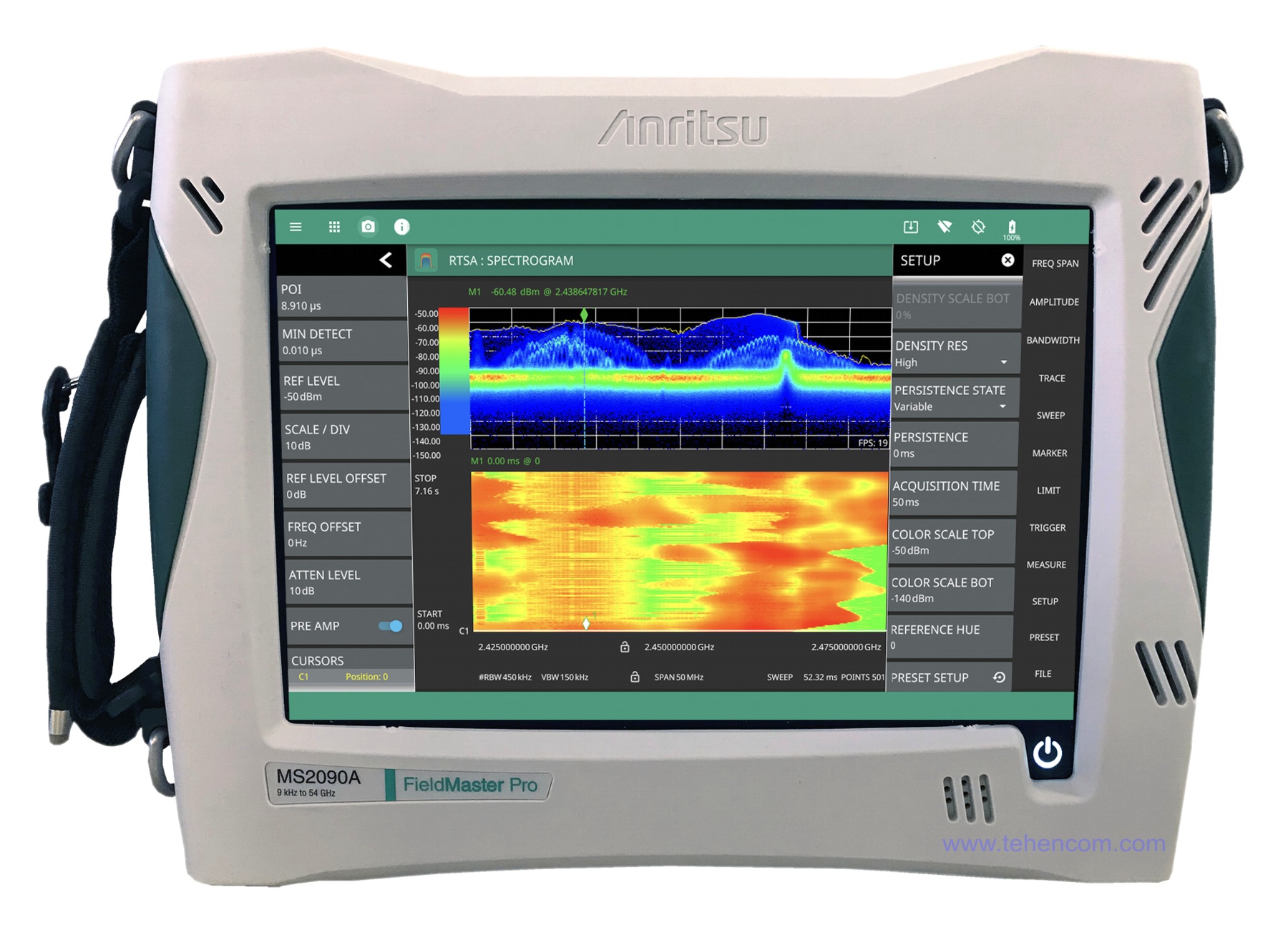Anritsu MS2830A series of spectrum and signal analyzers up to 43 GHz
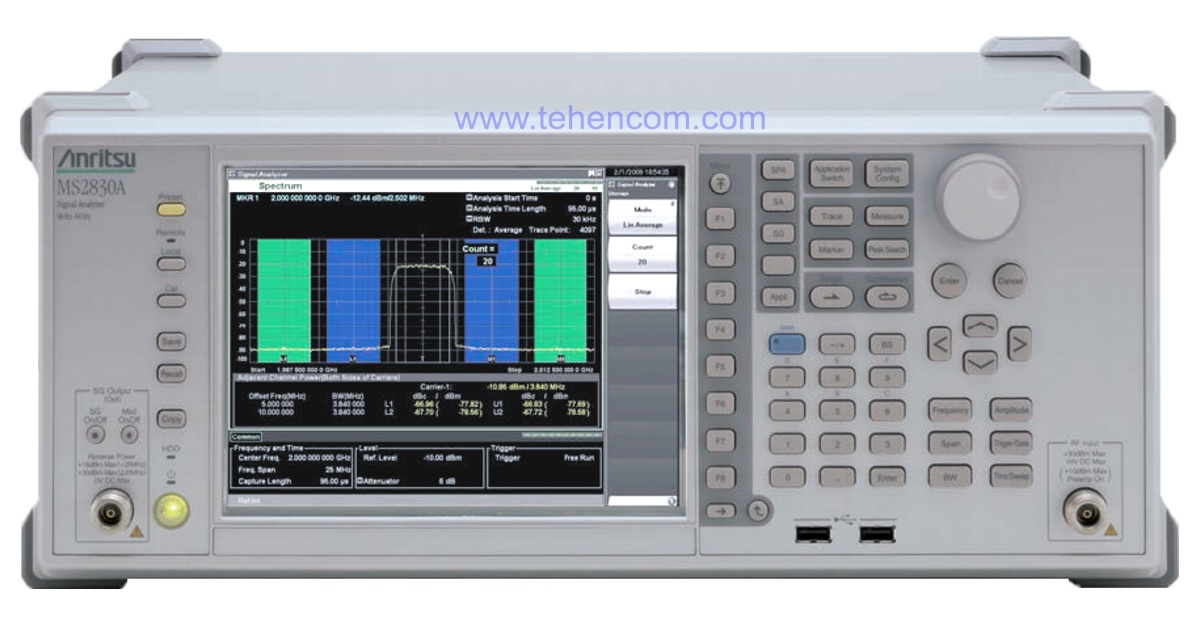
Brief description of the series
Spectrum and signal analyzers Anritsu MS2830A is the main line of functional, high-speed and at the same time economical analyzers for laboratory and production, manufactured by the company Anritsu. The analyzers of this series not only support the capture and analysis of wideband signals, but also, using the FFT, allow you to perform multifunctional analysis of signals in both the frequency and time domains. What's more, the MS2830A Series can be equipped with a built-in oscillator capable of generating both continuous and modulated waveforms for use as a reference in transmit path unit characterization and as an input signal for receive path characterization.
You can download a full description of all the characteristics of Anritsu MS2830A below on this page in the section Documentation. And the main differences between the four series of Anritsu laboratory spectrum analyzers and signals, see this comparison.
All models of the series
The Anritsu MS2830A series consists of five models, which are presented in this interactive table. To see all the characteristics of certain models, add them to the comparison.
| Model |
Maximum frequency
|
Signal analysis bandwidth
|
SSB phase noise
|
RF signal generation
|
Weight
|
|---|---|---|---|---|---|
|
MS2830A-040
|
3.6 GHz | 10 MHz 31.25 MHz 62.5 MHz 125 MHz | -115 dBc/Hz -133 dBc/Hz | 250 kHz – 3.6 GHz | 14.5 kg |
|
Expert's choice
MS2830A-041
|
6 GHz | 10 MHz 31.25 MHz 62.5 MHz 125 MHz | -115 dBc/Hz -133 dBc/Hz | 250 kHz – 6 GHz | 14.5 kg |
|
MS2830A-043
|
13.5 GHz | 10 MHz 31.25 MHz 62.5 MHz 125 MHz | -115 dBc/Hz -133 dBc/Hz | 250 kHz – 6 GHz | 13.5 kg |
|
MS2830A-044
|
26.5 GHz | 10 MHz 31.25 MHz 62.5 MHz 125 MHz | -115 dBc/Hz | — | 15 kg |
|
MS2830A-045
|
43 GHz | 10 MHz 31.25 MHz 62.5 MHz 125 MHz | -115 dBc/Hz | — | 15 kg |
Main features of the series
Frequency: 9 kHz – 3.6 GHz (model MS2830A-040).
Frequency: 9 kHz – 6 GHz (model MS2830A-041).
Frequency: 9 kHz – 13.5 GHz (model MS2830A-043).
Frequency: 9 kHz – 26.5 GHz (model MS2830A-044).
Frequency: 9 kHz – 43 GHz (model MS2830A-045).
Resolution (RBW): 1 Hz - 10 MHz (up to 31.25 MHz as an option).
Signal analysis bandwidth: 10 MHz; 31.25 MHz; 62.5 MHz; 125 MHz (depending on options).
Amplitude: +30 dBm to -153 dBm. Amplitude error: ±0.3 dB.
Hardware options: preamplifier (options 008 and 068), rubidium reference oscillator (option 001), vector signal generator (options 020 and 021), arbitrary waveform generator (option 028), BER measurement (option 026), low phase noise (option 066), phase noise measurement function (option 010), noise figure (noise factor) measurement function (option 017), preliminary EMC tests (option 016) and others (total 22 hardware options).
Software Options: generation, demodulation and analysis of wireless communication standards: LTE, GSM/EDGE, W-CDMA/HSPA+, TD-SCDMA, CDMA2000, EV-DO, HSDPA/HSUPA, WiMAX, WLAN (802.11), Bluetooth and others (total 37 software options).
Screen 21.3 cm (resolution 1024 x 768). Interfaces: USB, Ethernet, IEEE-488 (GPIB).
Weight: 13.5 kg. Dimensions: 426 x 177 x 390 mm. Working temperature: from +5°С to +45°С.
Areas of use:
- general purpose spectrum analyzer for laboratories and production lines
- development and testing of microwave devices
- phase noise measurement
- preliminary EMC tests
- generation, demodulation and quality analysis of wireless communication standards: LTE, GSM / EDGE, W-CDMA / HSPA +, TD- SCDMA, CDMA2000, EV-DO, HSDPA/HSUPA, WiMAX, WLAN (802.11), Bluetooth and more
Laboratory Spectrum and Signal Analyzers Anritsu MS2830A have a wide range of unique features and design advantages and, at the same time, a low price compared to similar analyzers. Standard analyzer features include: channel power, occupied bandwidth, adjacent channel power (ACPR), spectral emission mask, spurious emission, average pulse power, frequency counter, AM depth, FM deviation, multi-marker and marker lists , 10 peak markers, limit line, etc.
The standard capabilities of these analyzers can be upgraded with a wide range of hardware options (22 in total) as well as software options (37 in total). For a complete list of extension options, see Options and accessories, as well as in the section Documentation.
Need more above specifications? Watch the series Anritsu MS269xA.
Need minimal phase noise? Watch the series Anritsu MS2840A.
Need demodulation bandwidth up to 1 GHz? Watch the series Anritsu MS2850A.
Need compact portable design? Watch the series Anritsu MS2090A Field Master Pro.
Need ultra-portable analyzer up to 170 GHz? Watch the series Anritsu MS276xA.
Need real-time spectrum analyzer? Watch the series Tektronix RSA5000B.
You need a spectrum analyzer combined with an oscilloscope? Watch the series Tektronix MDO4000C.
Want to see the full list? This page has everything to Buy spectrum analyzer.
Video review of Anritsu MS2830A series
This video shows the basic modes of operation spectrum analyzer MS2830A: Measurements of channel power, occupied bandwidth, adjacent channel power leakage (ACPR), spectral emission mask, average pulse power, frequency counter, multi-marker and more. signal analyzer and also in the mode signal generator. After watching this video, you will get a visual representation of the capabilities of Anritsu MS2830A, its speed and visibility of the graphical user interface.
Excellent amplitude accuracy: ±0.3 dB
Because the Anritsu MS2830A Spectrum and Signal Analyzer provides level calibration over a wide frequency range, the instrument has excellent total signal level measurement errors. Absolute amplitude errors listed in other spectrum analyzer catalogs do not take into account important frequency characteristics such as linearity and attenuator switching error. In contrast, the MS2830A level calibration technology provides excellent level accuracy over a wide frequency range, even when switching frequency and attenuator.
MS2830A total leveling accuracy includes:
- frequency response;
- linearity;
- attenuator switching error.
Typically, spectrum analyzers calibrate the level at one frequency point, which gives an error when changing frequencies. And the MS2830A has two built-in signal generators for level calibration over a wide frequency range from 300 kHz to 4 GHz, minimizing measurement errors in this frequency range. For frequencies above 4 GHz, additional special methods are used to improve the accuracy of signal level measurements.
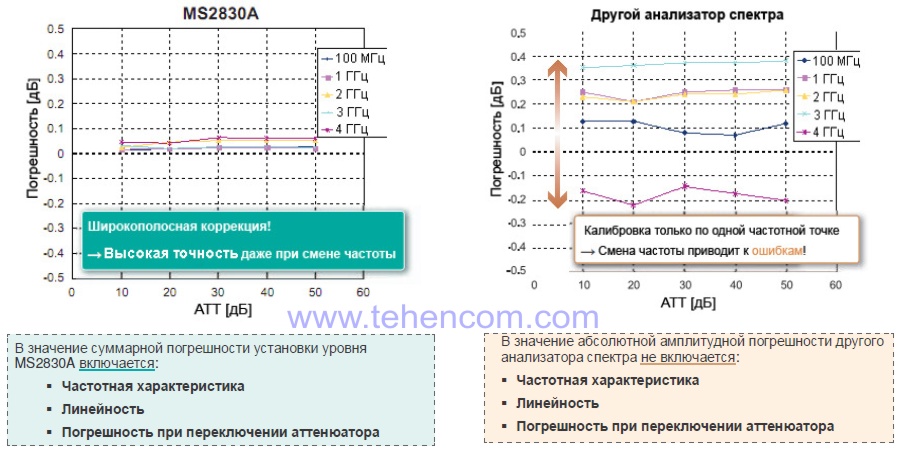
Wide dynamic range: 168 dB
The range of measured signals (the difference between TOI and DANL) is an important characteristic of spectrum analyzers. A low displayed average noise level (DANL) as well as a high 3rd order intercept level (TOI) is required for the equipment to function properly. If the spectrum analyzer has a low TOI value, then it can lead to distortion when working with signals with a high carrier level. Installing an attenuator will lower the carrier level, but it will also lower the level of weak spurious signals, making them difficult to measure.
The Anritsu MS2830A series signal and spectrum analyzers have an excellent signal range (168 dB) for making performance measurements on products such as base stations that require both large and small signals to be measured simultaneously.
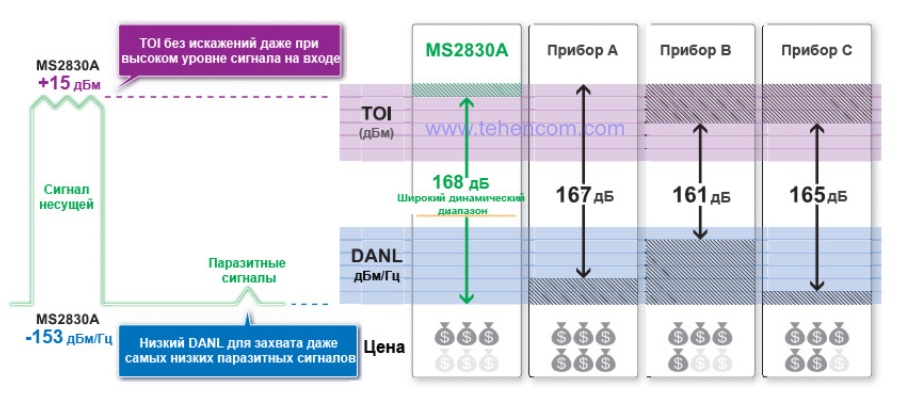
Examples of operation in various modes
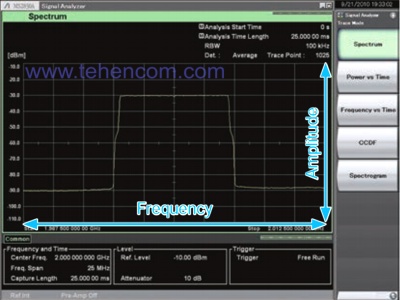
The "Spectrum" mode displays a graph with amplitude on the Y-axis and frequency on the X-axis. The resulting IQ data is processed using an FFT (Fast Fourier Transform) and converted from the time domain to the frequency domain for display as a spectrum. |
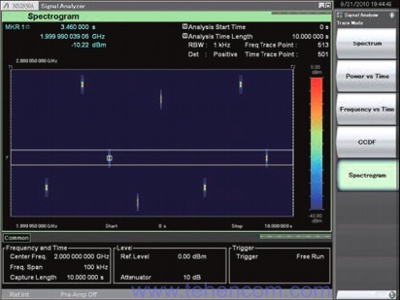
The "Spectrogram" mode displays the signal strength as a color with frequency on the Y-axis and time on the X-axis. The resulting IQ data is processed using an FFT. This mode is useful for monitoring frequency jumps and transients. |
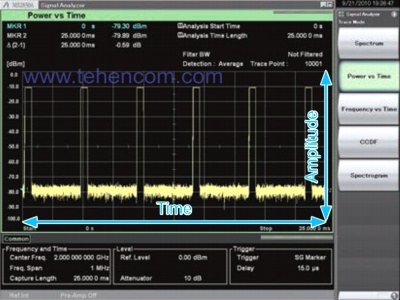
The "Power/Time" mode displays a graph with amplitude on the y-axis and time on the x-axis to check the changes in the power of the measured signals over time. |
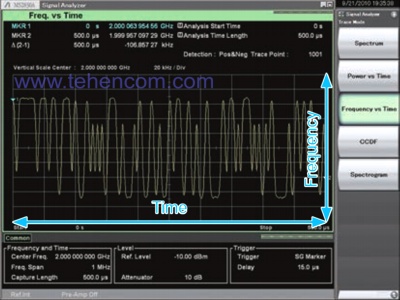
The "Frequency/Time" mode displays a graph with frequency on the Y-axis and time on the X-axis to check how the frequency of the measured signal changes over time. |
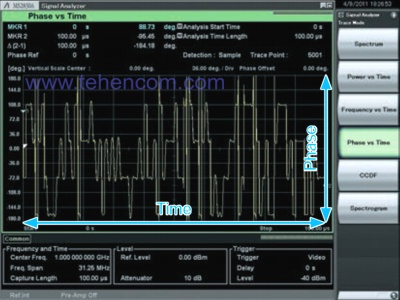
The "Phase/Time" mode displays a graph with phase on the Y-axis and time on the X-axis to check for changes in phase of the measured signals over time. |
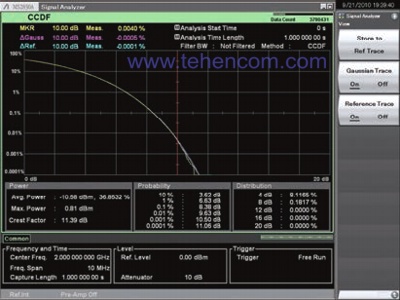
The "CCDF/APD" mode displays the Complementary Cumulative Distribution Function (CCDF) and the Amplitude Probability Distribution (APD). |
Built-in vector signal generator
Option MS2830A-020 (embedded vector signal generator) covers the frequency range from 250 kHz to 3.6 GHz, and the MS2830A-021 option covers the frequency range from 250 kHz to 6 GHz. The vector signal generator has a wide vector modulation bandwidth of 120 MHz, as well as large onboard memory for storing 64 Megasamples (or 256 Megasamples with option 027).
The level accuracy of the vector generator is at least comparable to that of a dedicated signal generator, and the adjacency power leakage ratio measurement capabilities are ideal for testing the transfer characteristics of devices such as amplifiers and the reception characteristics of base stations.
The combination of analyzer and signal generator functionality in one instrument makes it possible to create simple and compact measurement systems, and also simplifies the analysis of the signal received from the signal generator.
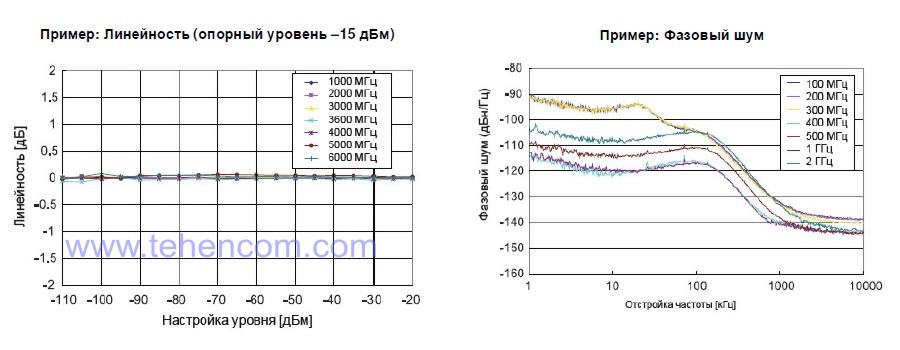
Differences between Anritsu laboratory analyzers
Currently, the Japanese company Anritsu produces four series of laboratory spectrum and signal analyzers: Anritsu MS2830A, Anritsu MS2840A, Anritsu MS2850A and Anritsu MS269xA. All of them are made in a classic desktop case and have a unified user interface. However, these four series differ in terms of features (options), measurement accuracy and cost.

Series Anritsu MS2830A (up to 43 GHz) belongs to the middle class, both in terms of measurement accuracy and cost. It provides an excellent price/feature ratio and is well suited for a wide range of spectrum and signal analysis applications. It is worth emphasizing the excellent opportunities for working with commercial communication standards, for example: LTE, W-CDMA, GSM, WLAN, etc. (excluding 5G). The MS2830A Series instruments can analyze signals up to 125 MHz bandwidth, however, if the analysis bandwidth exceeds 31.25 MHz, then there must be no other signals outside the analyzed bandwidth, otherwise image frequencies will be generated.
Series Anritsu MS2840A (up to 44.5 GHz) has improved performance compared to the MS2830A, especially in terms of phase noise at small offsets from the carrier. Demodulation of commercial communication standards is not supported, but the MS2840A series is great for developing and configuring devices using proprietary digital modulations based on QAM, APSK, etc., as well as various analog modulations. Like the MS2830A Series, the MS2840A Series can analyze signals up to 125 MHz bandwidth, however, if the analysis bandwidth exceeds 31.25 MHz, then there must be no other signals outside the analysis bandwidth, otherwise image frequencies will be generated.
Series Anritsu MS2850A (up to 44.5 GHz) provides the same measurement accuracy as the MS2840A series, plus it can demodulate and analyze signals in a record-breaking 1 GHz bandwidth. This series is ideal for designing and customizing 5G equipment, as well as any devices that use wide modulation bandwidths, such as satellite communications systems or native broadband digital communications systems. Commercial standards (LTE, W-CDMA, GSM, etc.) are also supported. In addition, the MS2850A Series analyzers can record up to 3.9 GS/s of digitized signal to internal memory and transfer it to a computer for advanced analysis, while sampling rates can reach 1.3 GS/s, which allows you to analyze any signal in detail, including impulse.
Series Anritsu MS269xA (up to 26.5 GHz) belongs to the high class in terms of measurement accuracy, and costs a little more than the MS2840A series. The main feature of the MS269xA series is the ability to analyze signals with a bandwidth of up to 125 MHz without the appearance of mirror frequencies. Demodulation of commercial communication standards is supported: LTE, W-CDMA, GSM, WLAN, etc. 5G demodulation and analysis is also supported.
All series of Anritsu laboratory spectrum and signal analyzers can be equipped with a variety of additional options that solve various practical problems, for example: EMC preliminary tests, phase noise measurements, complex waveform generation with built-in vector generator, high-precision frequency measurements with built-in rubidium reference generator, etc. Please note that when using external mixers, the operating frequency range of some laboratory analyzers can be extended up to 325 GHz.
Wide choice of frequency ranges
The Anritsu MS2830A spectrum and signal analyzer series contains 5 models that differ in frequency range:
- frequency: 9 kHz - 3.6 GHz (model MS2830A-040) with N type connectors;
- frequency: 9 kHz - 6 GHz (model MS2830A-041) with N type connectors;
- frequency: 9 kHz - 13.5 GHz (model MS2830A-043) with N type connectors;
- frequency: 9 kHz - 26.5 GHz (Model MS2830A-044) with K-type connectors (2.92 mm);
- frequency: 9 kHz - 43 GHz (Model MS2830A-045) with K-type connectors (2.92 mm).
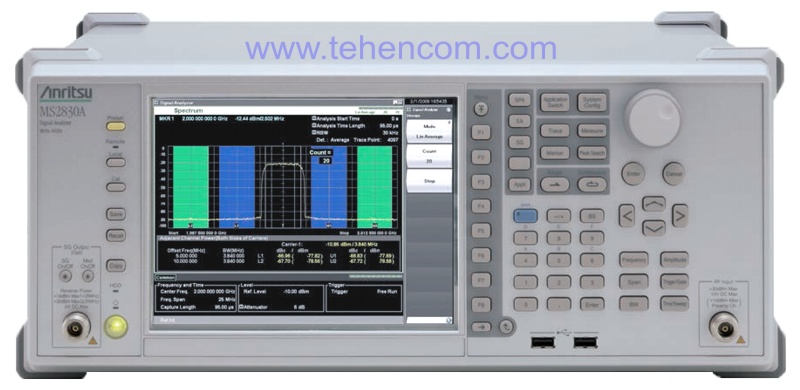
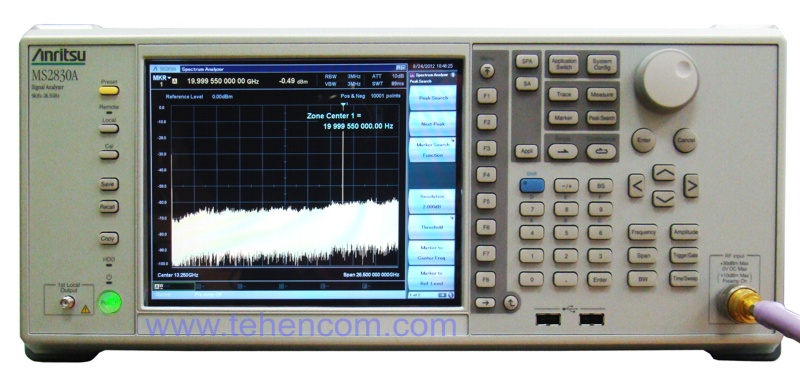
Specifications of Anritsu MS2830A
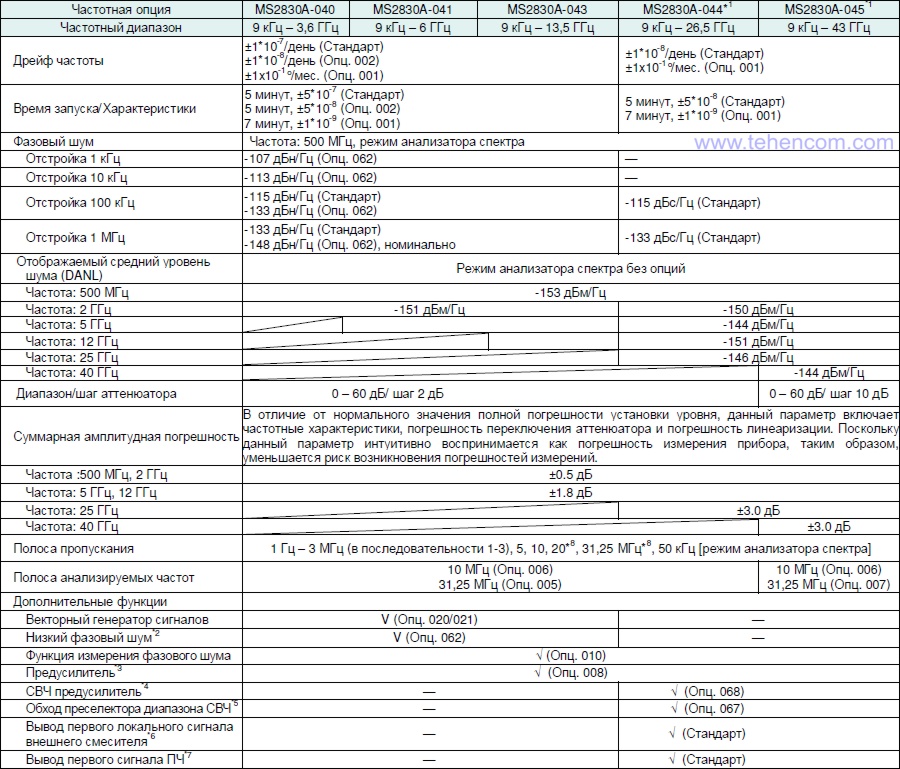
Anritsu MS2830A package contents
| Name | Short description |
| Anritsu MS2830A-040 | Handheld Spectrum and Signal Analyzer (9 kHz - 3.6 GHz) |
| or | |
| Anritsu MS2830A-041 | Handheld Spectrum and Signal Analyzer (9 kHz - 6 GHz) |
| or | |
| Anritsu MS2830A-043 | Handheld Spectrum and Signal Analyzer (9 kHz - 13.5 GHz) |
| or | |
| Anritsu MS2830A-044 | Handheld Spectrum and Signal Analyzer (9 kHz - 26.5 GHz) |
| or | |
| Anritsu MS2830A-045 | Handheld Spectrum and Signal Analyzer (9 kHz - 43 GHz) |
| - | Power cable |
| - | USB 2.0 flash drive |
| - | USB computer mouse |
| - | CD with software and documentation |
| - | 1 year warranty (can be extended to 3 and 5 years) |
Options and accessories for Anritsu MS2830A
Below is a list of hardware and software options for the Anritsu MS2830A series of signal and spectrum analyzers, which can be used to solve almost all tasks of measurement laboratories and production lines. For a complete list of options with a detailed description, see Documentation. In addition, you can choose auxiliary equipment from the following sections of our website: Measuring antennas and microwave accessories.
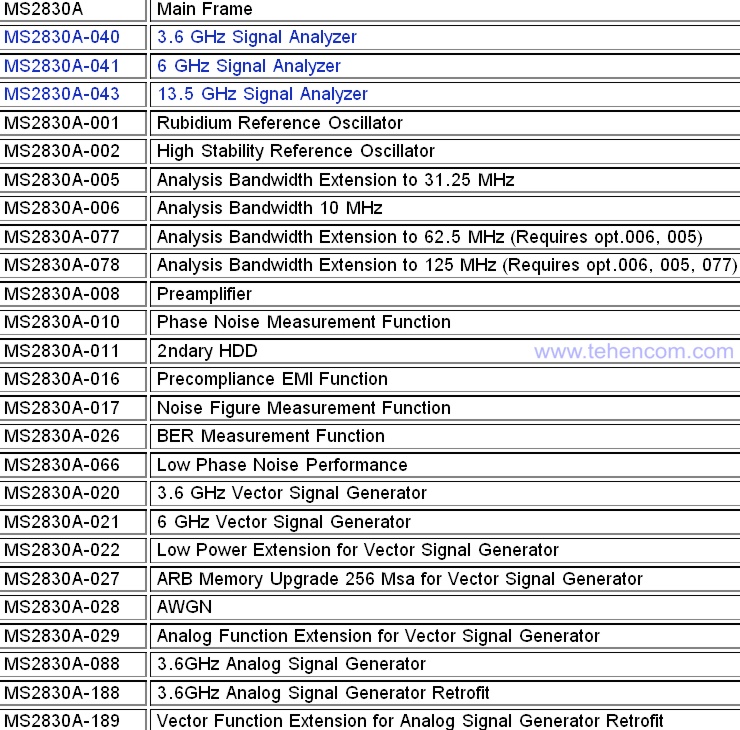
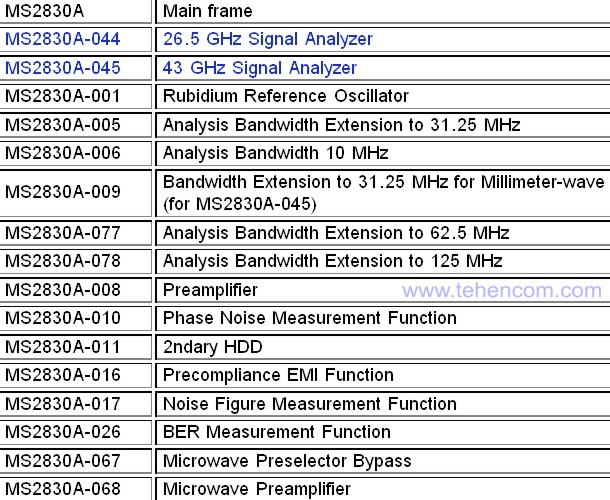
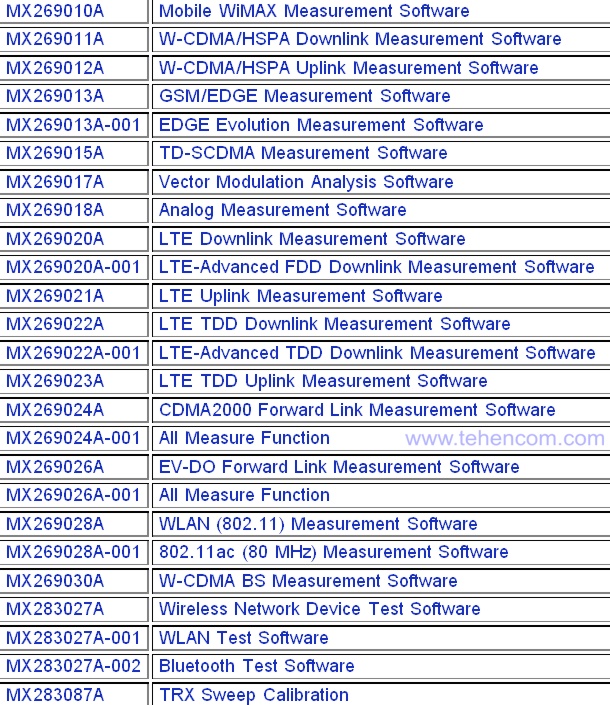
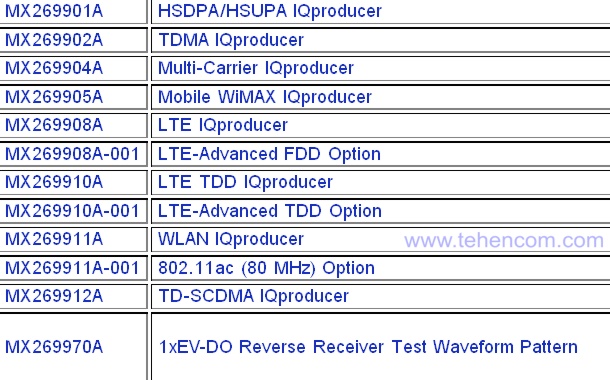
Documentation
This PDF documentation contains the most comprehensive description of the Anritsu MS2830A Series Analyzer features, specifications and modes of operation:
Description of analyzers Anritsu MS2830A-040, MS2830A-041, MS2830A-043 (in Russian) (40 pages; 9.4 MB)
Description of analyzers Anritsu MS2830A-044, MS2830A-045 (in Russian) (40 pages; 13.3 MB)
Anritsu MS2830A spectrum analyzer configuration (options) guide (12 pages; 768 KB)
Description of software options for Anritsu MS2830A analyzers (80 pages; 6.4 MB)
Description of software options for the MS2830A built-in vector signal generator (82 pages; 5.1 MB)
And here you can find our tips and other useful information on this topic:
Basic theory for spectrum analysis and signal analysis
How to buy equipment cheaper – discounts, special prices, demo and used devices
To simplify the process of choosing a spectrum and signal analyzer, you can use our experience and recommendations. We have over 20 years of practical supply experience and can immediately answer many questions about models, options, delivery times, prices and discounts. This will save your time and money. For this it's simple call us or write to us at E-mail and we will be happy to answer your questions.



